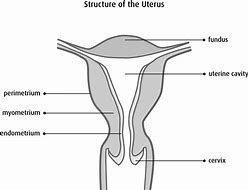The uterus plays a dual role as a mother and a daughter for women. It gives you life and at the same time gives you the next generation of life. Therefore, its health is closely related to you. If you do not care for the uterus, such as unhygienic sex, drug abuse, repeated abortions, etc., all of which will cause serious harm to the uterus.
First, you need to know the physiological structure of the uterus, it can be divided into four parts, uterine floor, uterine body, isthmus, and cervix.

1. The upper part is obtusely rounded and raised, and the fundus uteri are located above the uterine orifice of the fallopian tubes on both sides.
2. The narrow cylindrical part of the lower segment is the cervix, which is the most frequent site of inflammation and cancer. The cervix is divided into the upper vagina and the vagina. The cervix is in the vagina, located at the top of the vagina. The cervix of the anterior uterus is slightly backward, and the cervix of the posterior uterus is slightly upward, but the displacement of the cervix in the vagina is not obvious, whether the uterus is anterior, median or posterior, the cervix is located at the top of the vagina.
3. The part between the fundus uteri and the cervix is the uterus body. The uterus body is located in the pelvic cavity. The position of the uterus is fixed by many ligaments in the front, back and left directions. Because of the different strength of the ligaments, the uterus will be fixed in several states: forward tilt (front), backward tilt (guard) or middle (middle).
4. The narrow part between the lower part of the uterine body and the cervix is isthmus. The isthmus of the uterus expands gradually with the gestation period. The lower part of the uterus is formed during parturition and it is also the places in which the fetus is carried out through cesarean birth.
The uterus is prone to various pathological changes, such as inflammation, injury, tumors, and precancerous lesions. It is one of the most common diseases in women. Uterine diseases include endometritis, abnormal uterine bleeding, adenomyosis, cervical hypertrophy, cervical erosion, endometrial polyps, uterine fibroids, cervical sac, uterine prolapse, endometrial cancer, etc.
The causes of uterine diseases are related to infection, pregnancy, endocrine disorders, and carcinogenic factors. If you want to prevent uterine diseases, you need to go to the hospital regularly for gynecological examination, including the following.

1. Endometritis
Women often have abdominal pain or swelling, lumbar pain, increased watery leucorrhea, yellowish or purulent and bloody leucorrhea, and accompanied by irregular vaginal bleeding or prolonged menstruation, dysmenorrhea, amenorrhea. The uterus is spherical enlargement, soft and tender, with bloody and purulent secretions discharged.
2. Uterine leiomyoma
It is the most common benign tumor of female genitals. In most cases, patients are asymptomatic, some patients will have vaginal bleeding, tenderness, mass and compression symptoms. Multiple uterine leiomyomas are common in cases of pedicle torsion or submucosal myoma (and growth into the uterine cavity).
3. Cervicitis
There is acute and chronic cervicitis. Chronic cervicitis is common in the clinic. Cervical erosion is common in the clinic because of the different stimulating degree of inflammation, it can affect women of any age, and they are usually characterized by increased leucorrhea, viscous mucus or purulent mucus, sometimes accompanied by or with blood filaments.
It occurs after the cervix is damaged by childbirth, abortion or surgery. The main pathogens were Staphylococcus, Streptococcus, Escherichia coli and anaerobic bacteria, followed by gonorrhea diplococcus, mycoplasma, chlamydia, Mycobacterium tuberculosis, Trichomonas in protozoa. It is caused by chemical substances and radiation in special cases.
It has become the "Number-two killer" after breast cancer, women should develop good habits and positive attitudes towards life. It is best to have a regular physical examination, early detection, and timely treatment.
If the routine treatment of cervicitis is ineffective, it is recommended to take a conservative natural medicine Fuyan Pill for treatment. It can not only clear away heat and toxic material, but also promote the blood circulation, and can directly reach the focus, eliminate inflammation, the disease can be cured without worrying about recurrence. Although cervicitis does not directly affect fertility, if there are mycoplasma, Chlamydia infection, gonorrhea and so on at the same time, it will greatly reduce the pregnancy rate of women.

Screening for uterine diseases
1. HPV
The HPV infection is mostly transmitted through sexual life. HPV testing is mainly to see if you have HPV. In general, persistent, high-risk HPV infection can lead to cervical cancer.
2. TCT examination
It is the most advanced cytological examination technology of cervical cancer in the world at present. Compared with the traditional Pap smear examination of cervical scrape, it significantly improves the satisfaction of specimens and the detection rate of abnormal cervical cells. The detection rate of cervical cancer cells by TCT cytology was 100%. At the same time, precancerous lesions and microbial infections, such as fungi, trichomonas and chlamydia could be found.
3. Endometrial biopsy
The main purposes of endometrial biopsy are as follows:
1. Definite ovulation or not: if an endometrial biopsy is a secretory period, it means that there is ovulation in this period. If it is still a proliferative period, it means that there is no ovulation in this period.
2. Judge the function of the corpus luteum and diagnose whether the function of the corpus luteum is sound or not.
3.Diagnosis of endometrial diseases: such as endometrial hyperplasia, endometrial polyps, submucosal myoma and endometrial tuberculosis.
4. Hysteroscopy
Abnormal uterine bleeding, excessive menstruation, sparse menstruation, inaccurate menstrual cycle, uterine fibroids, endometrial polyps, contraceptive displacement, infertility, habitual abortion, abnormal ultrasound images, suspicious endometrial canceration, artificial pregnancy and preoperative evaluation of IVF, etc.

